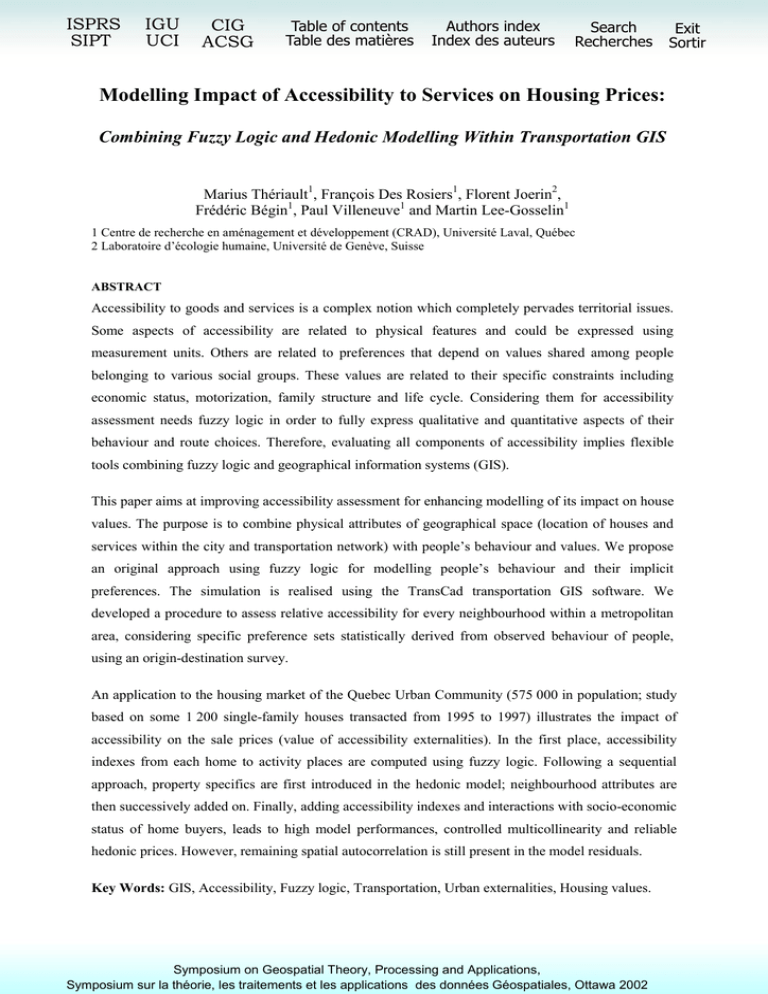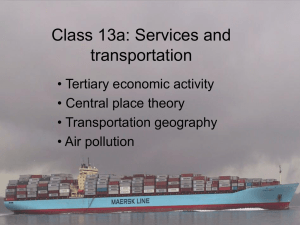Modelling Impact of Accessibility to Services on Housing Prices: ISPRS IGU
advertisement

ISPRS SIPT IGU UCI CIG ACSG Table of contents Table des matières Authors index Index des auteurs Search Recherches Exit Sortir Modelling Impact of Accessibility to Services on Housing Prices: Combining Fuzzy Logic and Hedonic Modelling Within Transportation GIS Marius Thériault1, François Des Rosiers1, Florent Joerin2, Frédéric Bégin1, Paul Villeneuve1 and Martin Lee-Gosselin1 1 Centre de recherche en aménagement et développement (CRAD), Université Laval, Québec 2 Laboratoire d’écologie humaine, Université de Genève, Suisse ABSTRACT Accessibility to goods and services is a complex notion which completely pervades territorial issues. Some aspects of accessibility are related to physical features and could be expressed using measurement units. Others are related to preferences that depend on values shared among people belonging to various social groups. These values are related to their specific constraints including economic status, motorization, family structure and life cycle. Considering them for accessibility assessment needs fuzzy logic in order to fully express qualitative and quantitative aspects of their behaviour and route choices. Therefore, evaluating all components of accessibility implies flexible tools combining fuzzy logic and geographical information systems (GIS). This paper aims at improving accessibility assessment for enhancing modelling of its impact on house values. The purpose is to combine physical attributes of geographical space (location of houses and services within the city and transportation network) with people’s behaviour and values. We propose an original approach using fuzzy logic for modelling people’s behaviour and their implicit preferences. The simulation is realised using the TransCad transportation GIS software. We developed a procedure to assess relative accessibility for every neighbourhood within a metropolitan area, considering specific preference sets statistically derived from observed behaviour of people, using an origin-destination survey. An application to the housing market of the Quebec Urban Community (575 000 in population; study based on some 1 200 single-family houses transacted from 1995 to 1997) illustrates the impact of accessibility on the sale prices (value of accessibility externalities). In the first place, accessibility indexes from each home to activity places are computed using fuzzy logic. Following a sequential approach, property specifics are first introduced in the hedonic model; neighbourhood attributes are then successively added on. Finally, adding accessibility indexes and interactions with socio-economic status of home buyers, leads to high model performances, controlled multicollinearity and reliable hedonic prices. However, remaining spatial autocorrelation is still present in the model residuals. Key Words: GIS, Accessibility, Fuzzy logic, Transportation, Urban externalities, Housing values. Symposium on Geospatial Theory, Processing and Applications, Symposium sur la théorie, les traitements et les applications des données Géospatiales, Ottawa 2002





